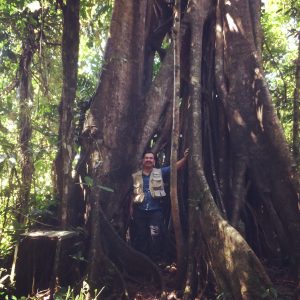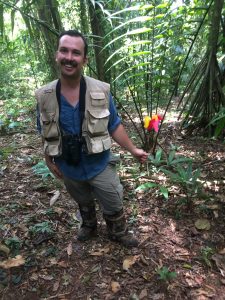 In working to save destroyed rainforests and to restore human dominated landscapes in tropical regions, land managers and landowners have been planting fig trees, or Ficus spp. individuals, on their properties for several years. This is due to fig trees being a keystone species in the tropics; Ficus spp. fruit all year round, are included in the diets of over 2,000 vertebrate species, and there are over 800 species of fig trees under the Ficus genus. While their importance to tropical ecosystems and their ability to bring back and sustain wildlife have been known for some time now, little is known on how effective fig tree recruitment is, both intentionally and naturally, across different forest fragments based on their ownership and land use types. As forest fragmentation has been a response to protect and restore pieces of forest throughout tropical regions since the 1990s, it still is uncertain how their differences in ownership and land use practices affect the overall success of tree and forest growth, and how well fig tree recruitment is doing in the face of persistent fragmentation.
In working to save destroyed rainforests and to restore human dominated landscapes in tropical regions, land managers and landowners have been planting fig trees, or Ficus spp. individuals, on their properties for several years. This is due to fig trees being a keystone species in the tropics; Ficus spp. fruit all year round, are included in the diets of over 2,000 vertebrate species, and there are over 800 species of fig trees under the Ficus genus. While their importance to tropical ecosystems and their ability to bring back and sustain wildlife have been known for some time now, little is known on how effective fig tree recruitment is, both intentionally and naturally, across different forest fragments based on their ownership and land use types. As forest fragmentation has been a response to protect and restore pieces of forest throughout tropical regions since the 1990s, it still is uncertain how their differences in ownership and land use practices affect the overall success of tree and forest growth, and how well fig tree recruitment is doing in the face of persistent fragmentation.
I am currently in Costa Rica working on an interdisciplinary research project funded by the National Science Foundation (NSF) through the Organization for Tropical Studies (OTS), that links different projects from social, biological, and ecological study designs together to illustrate the multifaceted implications of fragmentation. The project team collaboratively utilizes interviews, surveys, primate observations, and forest health analyses to uncover the complex and interrelated results of fragmentation. My personal project is looking at a possible variation between general tree success and Ficus spp. recruitment, across different forest fragments based on their political boundaries and land use types. This experiment requires me to travel to different forest fragments daily to execute my original study design out in the field, in order to make sense of how these different management practices are affecting the biotic components of forest health.
Abigail and I setting up a nested plot inside the forest at La Selva Biological Research Station
My research partner and fellow MSEM colleague, Abigail Kropf, set up nested plots (plots within a larger plot) in different forest fragments in order to answer our research questions, and I measure the abundance of woody and Ficus species across different life stages (seedling, sapling, and adult), canopy height, and canopy cover in each nested plot. As I’m focusing on the biotic and production factors of forest health, Abigail is focusing on the abiotic factors and measures pH, conductivity, moisture, and temperature of the soil community within the replicated nested plots, as well as within transects coming in and out of forest fragments.
As our ten week stay and data collection in Costa Rica is coming to an end next week, I look forward to analyzing how in combination, these different datasets illustrate telling and novel stories regarding fragmentation in the neotropics. This project and executing my own study design has further inspired me to do similar research in the future, and to continue to work at the plant level to uncover the truth about how we interact with our environment. Until next post, hasta luego!





